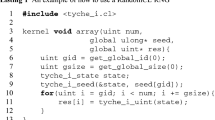Abstract
Extending 32-bit DX generators introduced by Deng and Xu (ACM Trans Model Comput Simul 13:299–309, 2003), we perform an extensive computer search for classes of 64-bit and 128-bit DX generators of large orders. The period lengths of these high resolution DX generators are ranging from 101915 to 1058221. The software implementation of these generators can be developed for 64-bit or 128-bit hardware. The great empirical performances of DX generators have been confirmed by an extensive battery of tests in the TestU01 package. These high resolution DX generators can be useful to perform large scale simulations in scientific investigations for various computer systems.
Similar content being viewed by others
References
Deng LY, Xu H (2003) A system of high-dimensional, efficient, long-cycle and portable uniform random number generators. ACM Trans Model Comput Simul 13: 299–309
Lehmer DH (1951) Mathematical methods in large-scale computing units. In: Proceedings of the second symposium on large scale digital computing machinery. Harvard University Press, Cambridge, MA, pp 141–146
Matumoto M, Nishimura T (1998) Mersenne twister: a 623-dimensionally equidistributed uniform pseudo-random number generator. ACM Trans Model Comput Simul 8: 3–20
Deng LY (2004) Generalized Mersenne prime number and its application to random number generation. In: Niederreiter H (eds) Monte Carlo and Quasi-Monte Carlo methods. Springer-Verlag, Berlin, pp 167–180
Deng LY (2005) Efficient and portable multiple recursive generators of large order. ACM Trans Model Comput Simul 15: 1–13
Lidl R, Niederreiter H (1994) Introduction to finite fields and their applications. Revised edition. Cambridge University Press, Cambridge
L’Ecuyer P, Blouin F, Couture R (1993) A search for good multiple recursive linear random number generators. ACM Trans Model Comput Simul 3: 87–98
Gentle JE (2003) Random number generation and Monte Carlo methods, 2nd edn. Springer-Verlag, New York
Hörmann W (1994) A note on the quality of random variates generated by the ratio of uniforms method. ACM Trans Model Comput Simul 4: 96–106
Kinderman AJ, Monahan JF (1997) Computer generation of random variables using ratio of uniform deviates. ACM Trans Math Softw 3: 257–260
Marsaglia G, Tsang W (2004) The 64-bit universal RNG. Stat Probab Lett 66: 183–187
Marsaglia G, Zaman A, Tsang W (1990) Toward a universal random number generator. Stat Probab Lett 8: 35–39
Nishimura T (2000) Tables of 64-bit Mersenne twisters. ACM Trans Model Comput Simul 10: 348–357
Doornik J (2007) Conversion of high-period random numbers to floating point. ACM Trans Model Comput Simul 17:article 3
L’Ecuyer P (1997) Bad lattice structures for vectors of non-successive values produced by some linear recurrences. INFORMS J Comput 9: 57–60
Knuth DE (1998) The art of computer programming, vol 2. Seminumerical algorithms, 3rd edn. Addison-Wesley, Reading
L’Ecuyer P (1996) Combined multiple recursive random number generators. Oper Res 44: 816–822
L’Ecuyer P (1999) Good parameter sets for combined multiple recursive random number generators. Oper Res 47: 159–164
Deng LY, Lin DKJ (2000) Random number generation for the new century. Am Stat 54: 145–150
L’Ecuyer P, Touzin R (2004) On the Deng–Lin random number generators and related methods. Stat Comput 14: 5–9
Damgard I, Landrock P, Pomerance C (1993) Average case error estimates for the strong probable prime test. Math Comput 61: 177–194
Crandall R, Pomerance C (2000) Prime numbers: a computational perspective. Springer-Verlag, New York
Williams HC, Seah E (1979) Some primes of the form (a n−1)/(a−1). Math Comput 33: 1337–1342
Brillhart J, Lehmer DH, Selfridge JL, Tuckerman B, Wagstaff SS Jr (2002) Factorizations of b n±1, b=2,3,5,6,7,10,11,12 up to high powers, 3rd edn. American Mathematical Society
Payne WH, Rabung JR, Bogyo T (1969) Coding the Lehmer pseudo number generator. Commun ACM 12: 85–86
L’Ecuyer P (1988) Efficient and portable combined random number generators. Commun ACM 31:742–748, 774
Deng LY, George EO (1990) Generation of uniform variates from several nearly uniformly distributed variables. Commun Stat B 19: 145–154
Deng LY, Lin DKJ, Wang J, Yuan Y (1997) Statistical justification of combination generators. Stat Sin 7: 993–1003
Matsumoto M, Wada I, Kuramoto A, Ashihara H (2007) Common defects in initialization of pseudorandom number generators. ACM Trans Model Comput Simul 17:Article 15
L’Ecuyer P, Simard R (2007) TestU01: a C library for empirical testing of random number generators. ACM Trans Math Softw 33(22): 1–40
Lewis TG, Payne WH (1973) Generalized feedback shift register pseudorandom number algorithm. J Assoc Comput Mach 20: 456–468
Panneton F, L’Ecuyer P, Matsumoto M (2006) Improved long-period generators based on linear recurrences modulo 2. ACM Trans Math Softw 32: 1–16
Wichmann BA, Hill ID (1982) An efficient and portable pseudo-random number generator. Appl Stat 31: 188–190
Marsaglia G (1985) A current view of random number generators. In: Computer science and statistics, sixteenth symposium on the interface. North-Holland, Amsterdam. Elsevier, pp 3–10
Author information
Authors and Affiliations
Corresponding author
Additional information
Communicated by X. Chen.
Rights and permissions
About this article
Cite this article
Deng, LY., Lu, H.HS. & Chen, TB. 64-Bit and 128-bit DX random number generators. Computing 89, 27–43 (2010). https://doi.org/10.1007/s00607-010-0097-9
Received:
Accepted:
Published:
Issue Date:
DOI: https://doi.org/10.1007/s00607-010-0097-9
Keywords
- Combined generators
- Empirical tests
- Equidistribution
- Linear congruential generator (LCG)
- Multiple recursive generator (MRG)
- MT19937




